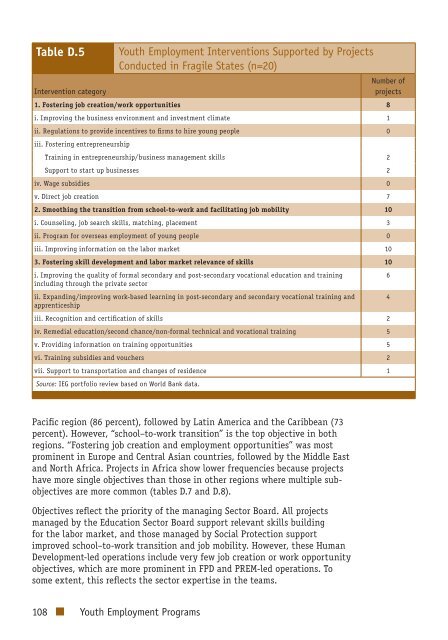Youth Employment Programs - Independent Evaluation Group
Youth Employment Programs - Independent Evaluation Group
Youth Employment Programs - Independent Evaluation Group
Create successful ePaper yourself
Turn your PDF publications into a flip-book with our unique Google optimized e-Paper software.
Table D.5Intervention category<strong>Youth</strong> <strong>Employment</strong> Interventions Supported by ProjectsConducted in Fragile States (n=20)Number ofprojects1. Fostering job creation/work opportunities 8i. Improving the business environment and investment climate 1ii. Regulations to provide incentives to firms to hire young people 0iii. Fostering entrepreneurshipTraining in entrepreneurship/business management skills 2Support to start up businesses 2iv. Wage subsidies 0v. Direct job creation 72. Smoothing the transition from school-to-work and facilitating job mobility 10i. Counseling, job search skills, matching, placement 3ii. Program for overseas employment of young people 0iii. Improving information on the labor market 103. Fostering skill development and labor market relevance of skills 10i. Improving the quality of formal secondary and post-secondary vocational education and training6including through the private sectorii. Expanding/improving work-based learning in post-secondary and secondary vocational training andapprenticeshipiii. Recognition and certification of skills 2iv. Remedial education/second chance/non-formal technical and vocational training 5v. Providing information on training opportunities 5vi. Training subsidies and vouchers 2vii. Support to transportation and changes of residence 1Source: IEG portfolio review based on World Bank data.4Pacific region (86 percent), followed by Latin America and the Caribbean (73percent). However, “school–to-work transition” is the top objective in bothregions. “Fostering job creation and employment opportunities” was mostprominent in Europe and Central Asian countries, followed by the Middle Eastand North Africa. Projects in Africa show lower frequencies because projectshave more single objectives than those in other regions where multiple subobjectivesare more common (tables D.7 and D.8).Objectives reflect the priority of the managing Sector Board. All projectsmanaged by the Education Sector Board support relevant skills buildingfor the labor market, and those managed by Social Protection supportimproved school–to-work transition and job mobility. However, these HumanDevelopment-led operations include very few job creation or work opportunityobjectives, which are more prominent in FPD and PREM-led operations. Tosome extent, this reflects the sector expertise in the teams.108 <strong>Youth</strong> <strong>Employment</strong> <strong>Programs</strong>
















